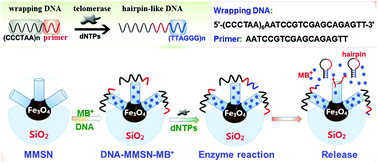Our official English website, www.x-mol.net, welcomes your
feedback! (Note: you will need to create a separate account there.)
Bioresponsive-controlled release of methylene blue from magnetic mesoporous silica from the electrochemical detection of telomerase activity
Analyst ( IF 3.6 ) Pub Date : 2017-08-01 00:00:00 , DOI: 10.1039/c7an01127j Minghua Lu 1, 2, 3, 4, 5
Analyst ( IF 3.6 ) Pub Date : 2017-08-01 00:00:00 , DOI: 10.1039/c7an01127j Minghua Lu 1, 2, 3, 4, 5
Affiliation

|
An electrochemical sensing platform was designed to monitor telomerase activity in HeLa cells, using bioresponsively controlled cargo release from magnetic mesoporous silica nanocontainers (MMSNs). The aminated MMSNs were first synthesized by a wet-chemistry method, then methylene blue (indicator) molecules were loaded into the pores with the aid of specifically designed wrapping DNA strands, and then the wrapping DNA-gated MMSNs were immobilized on a magnetic removable screen-printing carbon electrode. Upon target telomerase and dNTP introduction into the detection cell, the wrapping DNA strands on the MMSNs were prolonged to form rigid hairpin-like DNA structures, thus resulting in the dissociation of wrapping DNA strands from the MMSNs. Thereafter, the loaded methylene blue with redox activity was released out from the pores, thereby causing the increase in the electrochemical signal relative to the background signal. Under optimal conditions, an MMSN-based sensing system exhibited good voltammetric responses toward target telomerase activity within the dynamic linear range of 50–5000 cells per mL at a detection limit of 12 cells per mL in the HeLa extract. The reproducibility and generality of our strategy were acceptable by using somatic tumor cell lines. In addition, the inhibition effect of this system was also evaluated by using 3′-azido-3′-deoxythymidine as a telomerase inhibitor, receiving good results in this screening research.
中文翻译:

电化学检测端粒酶活性从磁介孔二氧化硅中生物响应控制释放亚甲基蓝
设计了一个电化学传感平台,以利用从磁介孔二氧化硅纳米容器(MMSN)释放的生物响应性控制的货物来监控HeLa细胞中的端粒酶活性。胺化的MMSN首先通过湿化学方法合成,然后借助专门设计的包裹DNA链将亚甲基蓝(指示剂)分子加载到孔中,然后将包裹DNA的MMSN固定在磁性可移动屏幕上-印刷碳电极。当靶端粒酶和dNTP引入检测细胞后,MMSN上的包裹DNA链会延长以形成刚性的发夹状DNA结构,从而导致包裹DNA链与MMSN分离。之后,负载的具有氧化还原活性的亚甲蓝从毛孔中释放出来,从而引起电化学信号相对于背景信号的增加。在最佳条件下,基于MMSN的传感系统在50-5000个细胞/ mL的动态线性范围内对目标端粒酶活性表现出良好的伏安响应,在HeLa提取物中的检测限为12个细胞/ mL。通过使用体细胞瘤细胞系,我们策略的可重复性和通用性是可以接受的。此外,还通过使用3'-叠氮基3'-脱氧胸苷作为端粒酶抑制剂评估了该系统的抑制效果,在该筛选研究中获得了良好的结果。基于MMSN的传感系统在50–5000个细胞/ mL的动态线性范围内,对目标端粒酶活性具有良好的伏安响应,在HeLa提取物中的检测限为12个细胞/ mL。通过使用体细胞瘤细胞系,我们策略的可重复性和通用性是可以接受的。此外,还通过使用3'-叠氮基3'-脱氧胸苷作为端粒酶抑制剂评估了该系统的抑制效果,在该筛选研究中获得了良好的结果。基于MMSN的传感系统在50–5000个细胞/ mL的动态线性范围内,对目标端粒酶活性具有良好的伏安响应,在HeLa提取物中的检测限为12个细胞/ mL。通过使用体细胞瘤细胞系,我们策略的可重复性和通用性是可以接受的。此外,还通过使用3'-叠氮基3'-脱氧胸苷作为端粒酶抑制剂评估了该系统的抑制效果,在该筛选研究中获得了良好的结果。
更新日期:2017-09-08
中文翻译:

电化学检测端粒酶活性从磁介孔二氧化硅中生物响应控制释放亚甲基蓝
设计了一个电化学传感平台,以利用从磁介孔二氧化硅纳米容器(MMSN)释放的生物响应性控制的货物来监控HeLa细胞中的端粒酶活性。胺化的MMSN首先通过湿化学方法合成,然后借助专门设计的包裹DNA链将亚甲基蓝(指示剂)分子加载到孔中,然后将包裹DNA的MMSN固定在磁性可移动屏幕上-印刷碳电极。当靶端粒酶和dNTP引入检测细胞后,MMSN上的包裹DNA链会延长以形成刚性的发夹状DNA结构,从而导致包裹DNA链与MMSN分离。之后,负载的具有氧化还原活性的亚甲蓝从毛孔中释放出来,从而引起电化学信号相对于背景信号的增加。在最佳条件下,基于MMSN的传感系统在50-5000个细胞/ mL的动态线性范围内对目标端粒酶活性表现出良好的伏安响应,在HeLa提取物中的检测限为12个细胞/ mL。通过使用体细胞瘤细胞系,我们策略的可重复性和通用性是可以接受的。此外,还通过使用3'-叠氮基3'-脱氧胸苷作为端粒酶抑制剂评估了该系统的抑制效果,在该筛选研究中获得了良好的结果。基于MMSN的传感系统在50–5000个细胞/ mL的动态线性范围内,对目标端粒酶活性具有良好的伏安响应,在HeLa提取物中的检测限为12个细胞/ mL。通过使用体细胞瘤细胞系,我们策略的可重复性和通用性是可以接受的。此外,还通过使用3'-叠氮基3'-脱氧胸苷作为端粒酶抑制剂评估了该系统的抑制效果,在该筛选研究中获得了良好的结果。基于MMSN的传感系统在50–5000个细胞/ mL的动态线性范围内,对目标端粒酶活性具有良好的伏安响应,在HeLa提取物中的检测限为12个细胞/ mL。通过使用体细胞瘤细胞系,我们策略的可重复性和通用性是可以接受的。此外,还通过使用3'-叠氮基3'-脱氧胸苷作为端粒酶抑制剂评估了该系统的抑制效果,在该筛选研究中获得了良好的结果。











































 京公网安备 11010802027423号
京公网安备 11010802027423号